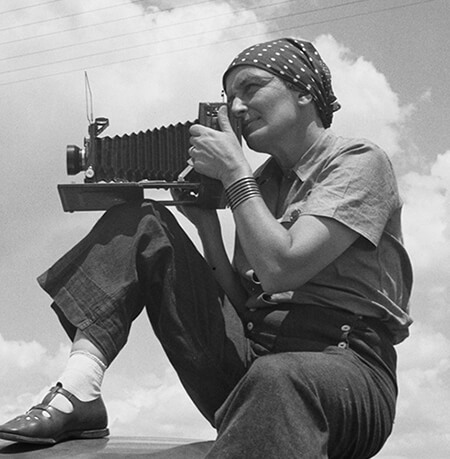
Photo : Paul S. Taylor
© The Dorothea Lange Collection, the Oakland Museum of California, City of Oakland. Gift of Paul S. Taylor
Portrait filmé
Dorothea Lange
Présentant des œuvres majeures de la photographe américaine de renommée mondiale Dorothea Lange (1895, Hoboken, New Jersey ; 1966, San Francisco, Californie), dont certaines n’ont jamais été exposées en France, l’exposition « Dorothea Lange. Politiques du visible » est articulée en cinq ensembles distincts. Ceux-ci mettent l’accent sur la force émotionnelle qui émane de ces photographies ainsi que sur le contexte de la pratique documentaire de la photographe. Plus d’une centaine de tirages vintage, réalisés de 1933 à 1957, sont mis en valeur par des documents et des projections qui élargissent la portée d’une œuvre déjà souvent familière au public grâce à des images emblématiques de l’histoire de la photographie comme White Angel Breadline (1933) et Migrant Mother (1936). Les tirages exposés appartiennent pour l’essentiel à l’Oakland Museum of California, où sont conservées les archives considérables de Lange, léguées par son mari Paul Schuster Taylor et sa famille.
The Politics of Seeing features major works by the world famous American photographer Dorothea Lange (1895, Hoboken, New Jersey–1966, San Francisco, California), some of which have never before been exhibited in France. The exhibition focuses on the extraordinary emotional power of Dorothea Lange’s work and on the context of her documentary practice. It features five specific series: the Depression period (1933-1934), a selection of works from the Farm Security Administration (1935-1939), the Japanese American internment (1942), the Richmond shipyards (1942-1944) and a series on a Public defender (1955-1957). Over one hundred splendid vintage prints taken between 1933 and 1957 are enhanced by the presence of documents and screenings broadening the scope of an œuvre often familiar to the public through images such as White Angel Breadline (1933) and Migrant Mother(1936), which are icons of photographic history.
The majority of prints in this exhibition belong to the Oakland Museum of California, where Lange’s
considerable archive, donated to the museum after her death by her husband Paul Shuster Taylor,
is conserved.
